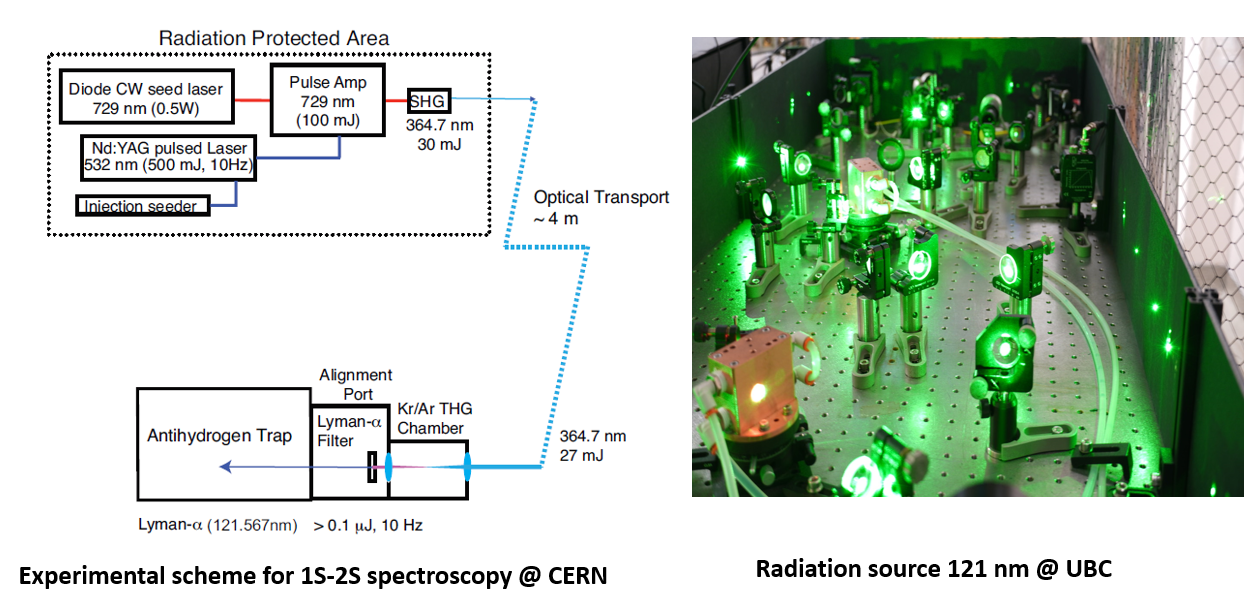Background
Antihydrogen, an atom made of an anti-proton and an anti-electron (positron), is an antimatter counterpart of atomic hydrogen. The international collaboration ‘ALPHA’ at CERN has lead the world in antimatter science by continuously improving their techniques for the creation and trapping of antihydrogen over the past decade. Momose’s group was invited to join the collaboration in 2012 to lead an ambitious program for the laser cooling of antihydrogen. One of the ultimate goals in antihydrogen research is to understand the matter-antimatter asymmetry in our Universe through ultra-high precision spectroscopy of antihydrogen, and to answer a great mystery in modern science; “What happened to antimatter after the Big Bang?” The ultimate precision for such studies is limited by the speed of antihydrogen; therefore it is essential to slow the anti-atoms to the lowest possible speeds. Though the technique of ‘laser cooling’ has revolutionized atomic physics over the past 3 decades, it has never been applied to antimatter atoms because of great technical difficulties − until now.
Current Status
Over the last several years, the Momose group has led the laser cooling group in the ALPHA collaboration, which has developed a technically challenging 121 nm laser source, and performed the world’s first Lyman-alpha laser spectroscopy measurements (Refs). The first in this series of seminal experiments was reported in Nature in 2018 (Refs=). In this work, Momose and his team observed the Lyman-alpha transition, for the first time in antimatter. This was not only a prerequisite for laser cooling, but also a significant observation on its own. In a subsequent report, published in Nature in 2020 (Ref), Momose’s team measured the Lamb shift in antihydrogen. The discovery of the corresponding shift in normal hydrogen in 1947 by Wills Lamb led to the development of modern quantum theory (QED: Quantum Electrodynamics) that would later be awarded the Nobel Prize. The observation of the equivalent effect in antimatter by Momose’s team constitutes a historic milestone for antimatter science for the test of QED in antimatter.

Future Goals
The Momose group is applying their Lyman-alpha light source for the laser cooling of antihydrogen. The first experiments the ALPHA collaboration is planning in 2021 and 2022 is the measurement of matter-antimatter gravity using laser cooled antihydrogen in a magnetic trap. They are also refining the precision of the 1S-2S transition frequency of antihydrogen for the test of the CPT violation. The new HAICU project lead by the ALPHA-Canada includes the development of anti-atom fountain for precision measurements and the creation of thefirst anti-matter molecule.
Recent publications
- “Investigation of the fine structure of antihydrogen”
M. Ahmadi et al. (ALPHA collaboration), Nature, 578, 375 -380 (2020). - “Observation of the 1S-2P Lyman-Alpha transition in antihydrogen”
M. Ahmadi et al. (ALPHA collaboration), Nature 561, 211-215 (2018). - “Narrowband Solid State VUV Coherent Source for Laser Cooling of Antihydrogen”
J. Mario Michan · Gene Polovy · Kirk W. Madison · Makoto C. Fujiwara · Takamasa Momose
Hyperfine Interactions, 235, (1), 29 – 36 (2015).